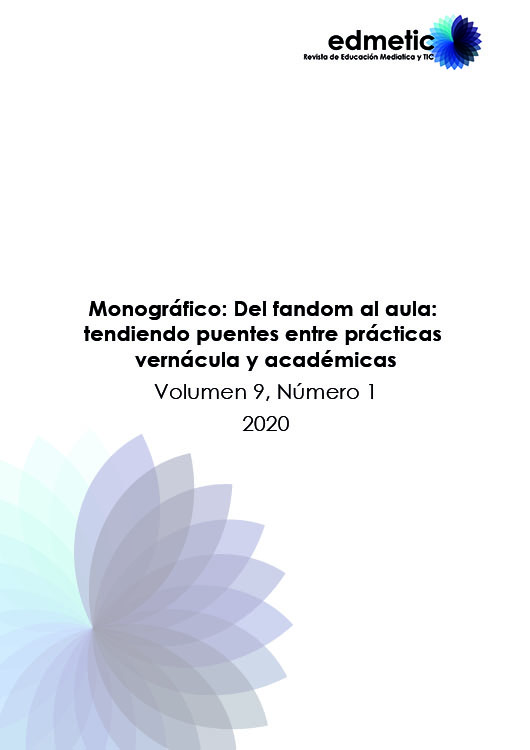El uso de las TIC en la integración educativa: el bullying, componentes y diferencia de género.
Main Article Content
Abstract
La enseñanza en la actualidad requiere enfrentarse a nuevos retos cada día, innovando y vinculando los hechos pedagógicos a la realidad educativa y social, para la mejora constante del aprendizaje en el aula. Para lograr este objetivo, corresponde a la educación fomentar, igualmente, el desarrollo ético y social a partir de acciones y estrategias que promuevan la integración, el diálogo y la tolerancia, entre otras, así como realizar actividades que ayuden a conocer y reflexionar al alumnado sobre los problemas más apremiantes de nuestra sociedad y le sirvan para resolver conflictos, pues la escuela ha sido desde siempre una constructora de valores y competencias. Con nuestra investigación hemos generado y puesto en práctica un plan de integración educativa de inspiración dialógica en Educación Secundaria, a través de un proyecto comunicativo de recursos didácticos y multimedia mediante el uso didáctico del cine y las tecnologías de la información, para la modificación o erradicación del maltrato escolar entre iguales, el llamado bullying, un fenómeno frecuente que afecta a todas las clases sociales. Su desarrollo práctico aborda la necesidad de diseñar y aplicar actividades pedagógicas y formativas basadas en las TIC y sus posibilidades educativas exitosas para la integración igualitaria
Today's teaching requires facing new challenges every day, innovating and linking the pedagogical facts to the educational and social reality, for the constant improvement of learning in the classroom. To achieve this goal, it is up to education to promote, as well, ethical and social development based on actions and strategies that promote integration, dialogue and tolerance, among others, as well as carrying out activities that help to know and reflect on students about the most pressing problems of our society and to solve conflicts, because the school has always been a builder of values and skills. With our research we have generated and put into practice an educational integration plan of dialogical inspiration in Secondary Education, through a communicative project of didactic and multimedia resources through the didactic use of cinema and information technologies, for the modification or eradication of scholastic abuse between equals, the so-called bullying, a frequent phenomenon that affects all social classes. Its practical development addresses the need to design and apply pedagogical and formative activities based on ICT and its successful educational possibilities for equal integration.
Downloads
Article Details
TRANSFER RIGHTS AND COMMITMENTS TO EDMETIC, REVISTA DE EDUCACIÓN MEDIÁTICA Y TIC
E-ISSN: 2254-0059
The undersigned author(s) of article entitled:
- Transfer to EDMETIC, Revista de Educación Mediática y TIC publishing rights of the article mention before. The magazine will have the right to publish in any format or media this article.
- The author(s) claim that this article is original and which has not been published before in any format and wasn´t submitted for evaluation to another publication.
- The author(s) claim that this article has the copyright´s permissions for publication
- The author(s) accept the changes to the contents on the review, and changes in the style of the manuscript by the Editorial Board of EDMETIC, Revista Educación Mediática y TIC.
- The author(s) declare that they have complied with the ethical principles of research.
- The author(s) not be subject to personal or business association that involves a conflict of interest with article presented
- El author(s) undertakes to give the primary sources of information, if requested.
Date:
Author(s) names and signatures (1):
(1) Fill the form and send to: revistaedmetic@uco.es
References
Cabero, J. (2015). Innovando en educación: la utilización de nuevos escenarios tecnológicos. Revista del Fórum Europeo de Administradores de la Educación (23), 14-18. Recuperada de: https://dialnet.unirioja.es/servlet/articulo?codigo=5004850
Cabero, J. y Barroso, O. (2016). La formación del profesorado en TIC: una visión del modelo TPACK. Revista de teoría, investigación y práctica (28), 647-663. Recuperada de: https://dialnet.unirioja.es/servlet/articulo?codigo=5663653
Canals, S. (2010). Si todo es bullying, nada es bullying. Santiago de Chile: Uqbar Editores.
Cacheiro, M.L. (2011). Recursos educativos TIC de información, colaboración y aprendizaje. Píxel-Bit. Revista de Medios y Educación (39), 69-81.
Cramer, D. (1997). Fundamental Statistics for Social Research: Step- by step Calculations and Computer Techniques Using SPSS for Windows. . Londres, Nueva York: Routledge.
Del Rey, R., Mora-Merchán, J. A. y Ortega, R. (2001). Violencia entre escolares. Revista Interuniversitaria de formación del profesorado; (41), 95-113.
Elliot, M. (2002). Bullying a practical guide to copying for schools. Edimburgo, Reino Unido: Pearson Education.
Elliot, J. (1993). El cambio educativo desde la investigación acción. Madrid: Morata.
Flecha, R. (2011). The dialogic sociology of education. International Studies in Sociology of Education, 21(1), 7 – 20. Recogido en la web: (https://www.tandfonline.com/doi/abs/10.1080/09620214.2011.543849)
Ibarrola, S. e Iriarte, C. (2014). La atención al clima escolar del aula, base de la educación para la convivencia: Claves para el profesor. Revista de Ciencias de la Educación: Órgano del Instituto Calasanz de Ciencias de la Educación, 237, 39-57.
Kemmis, S. y Mc Taggart, R. (1988). The Action Research Planner. Melbourne: Deakin University Press.
KiVa Spain- KiVa Anti- Bullying Program. Recuperado el 5 de abril de 2019 de http://www.kivaprogram.net/spain
Rangel, A. (2015). Competencias docentes digitales: propuesta de un perfil. Pixel-Bit. Revista de Medios y educación, ( 46), 235-248.
Salinas, J., Pérez, A. &De Benito, B. (2008). Metodologías centradas en el alumno para el aprendizaje en red. Madrid: Síntesis.
Strohmeier, D. & Noam, G. (2012). Bullying in schools: What is the problem, and how can educators solve it? New Directions for Youth Development, (133), 7-13.
Topcu, C.; Yildirim, A. & Erdur-Baker, O. (2013). Cyber Acoso escolar @ Schools What Do Turkish Adolescents Think. International Journal for the Advancement of Counselling, 35 (2), 139-151.
